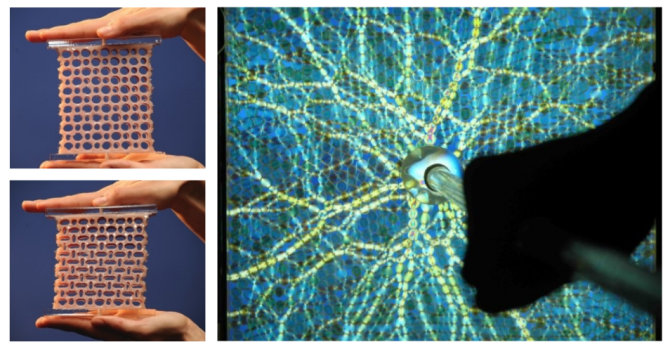Visualize the strain: using photoelasticity to visualize strain in metamaterials before they break
Push on a soft material, like a rubber tire or a gelatin pudding, and it will deform; Push even harder and it will break, simple as that. Now imagine a soft material that has regions where the material is soft and regions where the material is stiff. How will these materials deform and where will these materials break? Do you have a clue? We offer a Bsc/Msc project to find this out using an approach that allows strain visualization in macroscopic networks!
In this project, you will synthesize macroscopic networks with a specific design, also called metamaterials, see figure 1. These networks will be synthesized by pouring so-called photo-elastic materials in a 3D-printed mold. The advantage of using photoelastic materials is shown in figure 2; when deformed, a photoelastic material will show birefringence. Using cross polarizers one can than visualize the strain in a material under deformation. This property will be used in this project to follow the strain build up in a network with controllable topology while applying a load on the network until it fractures. Varying the network topology, by printing varying molds with a 3D printer, will allow us to study the effect of network topology on the strain build up and fracture process in the network.
The work in this project will be complemented with simulations on so-called weakest-links or discrete spring models, which are also carried out in our group. Depending on you research preferences and the length of the project, you can be involved in these simulations as well.

Are you interested in this project? I would like to come in contact with you! Just send an e-mail to Sven Boots (sven.boots@wur.nl) and I am happy to discuss the project with you!
Methods and techniques
- Fracture Mechanics
- Lab techniques (3D printing, Optics, tensile testing)
- Data analysis using MATLAB/python